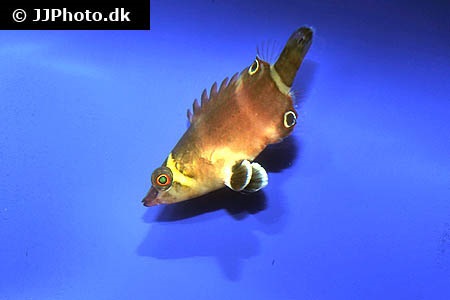Wetmorella nigropinnata


| Latin name | Wetmorella nigropinnata - (Seale, 1901) |
|---|---|
| Local name | Sharpnose wrasse |
| Family | Labridae - Wetmorella |
| Origin | East Indian Ocean, West Indian Ocean, Australia, Japan, The Red Sea, Indonesia, East Pacific, Central/West Pacific |
| Max length | 8 cm (3.1") |
| Minimum volume |
50 l (13 gal) |
|---|---|
| Hardiness |
Hardy |
| Suitable for aquarium |
Suitable with care |
| Reef safe |
Always reef safe |
| Aggressiveness | Docile |
| Recommended |
Small crustaceans (Krill, mysis, artemia...) Zooplankton (Cyclops, pods...) |
|---|
This species is known to jump out of open aquaria.
This species can be kept in a small tank, if it is specifically equipped to meet its needs.
It is recommended however, to keep it in an aquarium which is larger then described above.
This species must be fed with an appropriately varied diet.
This species is very sensitive during transportation and acclimatizing into the aquarium.
This species thrives best when there is a sufficiently large amount of micro life (copepods, amphipods or similar) in the aquarium, so that the it can always find their own food.
This fish requires feeding several times a day, especially when newly added.
When the fish can find its natural food in the aquarium it requires less frequent feeding.
This species is very shy and docile, so one should be careful when keeping it with more aggressive fish.
Several specimen of this species can coexist in the same aquarium, provided they are introduced simultaneously.
This species can change gender from female to male.
When a male is needed, a female changes sex and takes on the role.
Wetmorella species are very small thus these Wrasses are well suited to nano aquaria. They are peaceful and live of a diet of invertebrates, but if they cannot find their own food they need feeding several times a day.
They should not be kept with aggressive fish. One can keep more of these Wrasses together, if the tank is larger than 75 gal (300 liters).
These fish is shy and spend a lot of time amongst the rocks, thus it is imperative that it is peaceful in and around the tank, if they are to be visible.
Wrasses are nearly always seen in reef aquaria, since many of the species are both attractive and useful in battling a range of unwanted invertebrates like i.e. flatworms, pyramide snails.
These fish live of everything from zooplankton to large crustaceans, sea urchins and the like.
The needs and behaviour of Wrasses vary greatly, so it is vital to familiarize oneself with the specific species before buying one.
| Aquarium trade | Yes |
|---|---|
| Distribution | Indo-Pacific: Red Sea to the Marquesan and Pitcairn islands, north to Ryukyu Islands, south to the southern Great Barrier Reef and New Caledonia. |
| English common names |
Yellow-banded possum wrasse Blackspot pigmy wrasse Black-spot pigmy wrasse Possum wrasse |
Scott Michael. Aquarium Fish: Possum Wrasses, Genus Wetmorella - Advanced Aquarist - (English)
Scott W. Michael. 2009. Wrasses and Parrotfishes (Reef Fishes Series Book 5) - TFH Publications / Microcosm Ltd. - (English)

